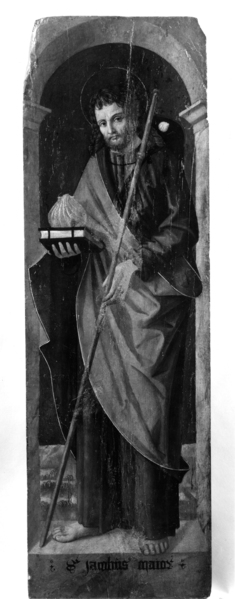Four Panels: St. Peter, St. John the Baptist, St. Roch, St. James the Greater
(Renaissance Europe )
Each of these panels depicts an individual saint standing beneath an arch before a distant landscape. The saints are identifiable by the inscriptions beneath their feet and the attributes that they carry. The apostle Peter (37.508A) holds the keys to heaven; John the Baptist (37.508B) wears a camel’s skin shirt (a reference to years spent preaching in the desert) and holds a reed cross and tiny lamb (the “Lamb of God,” a term he used to describe Jesus Christ); Roch (37.508C), a common protector against plague, carries a pilgrim’s staff and points to his own plague boil on his thigh; and James the Great (37.508D) carries a cockle shell and pilgrim’s staff, the latter a reference to the famous pilgrimage destination dedicated to him, Santiago de Compostella in Spain. The panels may have functioned as organ shutters: in Renaissance Italy, painted panels of full-length standing saints were often hinged to the sides of organ pipes, over which they were folded when the instrument was not in use.
The artist remains unknown. The illumination of the figures from a clear, warm light, falling from the left and rendering them almost statuesque, suggests they painted in or near Venice in the early 1500s by someone in the circle of Giovanni Bellini (ca. 1431/36-1516), famous for his depiction of light. After the panels were purchased by Henry Walters they were variously assigned to Niccolò Rondinelli (documented 1495-1502) and Pier Maria Pennacchi (1464-ca. 1515), both active in Venice and its surroundings in the late 1400s and early 1500s. In the 1970s they were reassigned to another painter from the region, Pellegrino da San Daniele (1467-1547). The latter suggestion is perhaps the most convincing but the question ultimately remains open.
Inscription
Provenance
Provenance (from the French provenir, 'to come from/forth') is the chronology of the ownership, custody, or location of a historical object. Learn more about provenance at the Walters.
William T. / Henry Walters Collection, Baltimore, prior to 1916 [mode of acquisition unknown]; Walters Art Museum, 1931, by bequest.
Geographies
Italy, Venice (Place of Origin)
Measurements
St. Peter painted surface H: 52 9/16 x W: 15 7/8 x Approx. D: 1 in. (133.5 x 40.4 x 2.6 cm); St. John the Baptist painted surface H: 52 3/4 x W: 16 5/16 x D: 1 1/8 in. (134 x 41.5 x 2.8 cm); St. Roch painted surface H: 52 5/8 x W: 16 7/16 x Approx. D: 1 in. (133.7 x 41.7 x 2.6 cm); St. James the Great painted surface H: 52 13/16 x W: 16 7/16 x Approx. D: 1 in. (134.2 x 41.7 x 2.6 cm)
Credit Line
Acquired by William T. or Henry Walters, before 1916
Location in Museum
Not on view
Accession Number
In libraries, galleries, museums, and archives, an accession number is a unique identifier assigned to each object in the collection.
In libraries, galleries, museums, and archives, an accession number is a unique identifier assigned to each object in the collection.
37.508






